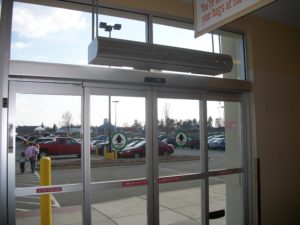 No matter what type of business you run, almost any commercial building can benefit from the installation of air curtains. From restaurants to warehouses, the benefits are applicable to everyone: saving money by reducing energy consumption, keeping interior spaces more comfortable, stopping flying insects, and more. Whether it’s a general all-purpose solution you need for a front door, or a more specialized piece of hardware for a walk-in refrigerator or an interior warehouse door, choosing the right air curtain makes all the difference.
No matter what type of business you run, almost any commercial building can benefit from the installation of air curtains. From restaurants to warehouses, the benefits are applicable to everyone: saving money by reducing energy consumption, keeping interior spaces more comfortable, stopping flying insects, and more. Whether it’s a general all-purpose solution you need for a front door, or a more specialized piece of hardware for a walk-in refrigerator or an interior warehouse door, choosing the right air curtain makes all the difference.
With that in mind, one of the most important things to consider as you look at air curtains for your business is the size of the unit. In other words, how big and how powerful does it need to be in order to maximize performance? Too small, and you won’t get the climate zone separation you want. Too large, and you risk creating an uncomfortable wall of air patrons must walk through, or you could end up consuming more energy than you save. So how do you appropriately size an air curtain for your application? There are several factors to consider.
Location Matters Most for Sizing
Far and away the most important thing to consider is where you will place the air curtain, or in other words, what type of door it will cover. Something for use in a small cafe, for example, is going to be drastically different than a unit for use in even a bigger restaurant, to say nothing of industrial applications. Start by considering your purpose and taking some initial measurements, such as the height of the door and its width. Consider how much room you have for the equipment itself. Many air curtains are very compact, but larger units require more space to operate. Remember that you will need a space slightly wider than the width of the door itself. Precise dimensions for air curtains are easy to access and can allow you to develop a sense of how much room you have to utilize.
Speaking of operational space, air curtains draw in ambient air to create their barrier of separation — that means you’ll need room for the intake, too. A high-velocity air curtain in a small space will struggle to achieve full coverage as it lacks access to a sufficiently large volume of air. As you consider the placement of your air curtains, don’t forget to consider that factor as well. Manufacturers and distributors can assist you with specific volumetric numbers and calculations to determine the usable air in your space.
What Level of Air Velocity is Appropriate?
Physical space may be important for actually getting the curtain into place, but once it’s there, operation is just as important. To function correctly, air curtains must direct air downward at a velocity strong enough to reach the ground. Otherwise, air or dust infiltration can still occur easily, defeating the purpose of the device. However, as mentioned, you do not want the air to be too strong; instead, it should always feel gentle to those entering. In small-scale applications, as in restaurants, the correct velocity can usually be around 15 feet per second. That’s about 10 miles per hour, or no stronger than the breeze you might encounter on a slightly windy day — perfect for keeping out flies without disturbing visitors.
In warehouses and other large-scale commercial applications, especially where the curtain must be positioned high above the floor, it is acceptable to use much higher air velocities, up to 50 feet per second or more. Keep in mind this is the velocity “at the nozzle,” or as it exits the unit. The airflow will slow down as it reaches the floor, so there are no concerns about warehouse staff briefly experiencing a gale force wind in the midst of the workday. Determining the right velocity for your space necessitates a closer look at the specifics.
Other Important Characteristics to Keep in Mind
As you work to choose an air curtain, don’t forget that the shape of the space will have an impact on the unit’s performance. Additional entrances/exits into the space, or a larger pressure difference between the interior and exterior, can complicate matters. Both of these can cause an air curtain otherwise correctly sized to function sub-optimally. For complex spaces, you may require a larger air curtain — or multiple units — to compensate for the issues that can occur. Likewise, how frequently the doors the units cover open should also come into play. Curtains that must operate semi-continuously will face different demands than a unit that only turns on briefly a few times an hour.
Seeking Professional Help to Size an Air Curtain
Ultimately, the best way to ensure that you acquire an air curtain suitable for your operational requirements is to enlist experienced professional help. Not only can a pro help you work through questions and concerns you may have about these machines, but they can also help you to determine the right solution based on your building’s setup. For example, rooms with multiple doors and a complex climate control scenario can become much easier to navigate when you have trusted advice informing your next move.
Taking advantage of all the benefits offered by air curtains should be an option available to every business. Take the next steps in determining how you can reduce energy costs and improve comfort with an appropriately sized air curtain. For assistance, answers to your questions, and access to industry-leading products contact Air Door Distributors today.

